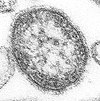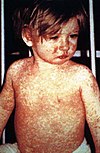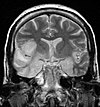Video:Measles
| Measles (Tutorial) | |
|---|---|
| File:En.Video-Measles.webm | |
| On Commons | |
| Steps for video creation | |
| Step 1 | Preview my changes (10 sec) |
| Step 2 | Upload to Commons (10 min) |
Definition
Measles is a highly contagious infectious disease, caused by the measles virus.[1][2] It is also known as rubeola.

vs Rubella and Roseola
not to be confused with Rubella, (German measles) and roseola, which are different diseases, caused by unrelated viruses.[3]

Onset of illness
Symptoms, usually develop 10–12 days after exposure to an infected person, and last 7–10 days.[4][5]

Initial symptoms
Initial symptoms typically include, fever, often greater than 40 °C (104 °F), cough, runny nose, and inflamed eyes.[1][6]

Koplik's spots
Small white spots, known as Koplik's spots, may form inside the mouth, two or three days after the start of symptoms.[6]

Rash
but the classic sign, is a red (flat) rash, which usually starts on the face three to five days after the start of symptoms, and then spreads to the rest of the body.[6]

Common complications
About 7% of cases have complications, including diarrhea, middle ear infection, and pneumonia.[7]

Less likely complications
Less commonly, seizures, blindness, or inflammation of the brain, may occur.[4][7]

Cause
Measles is an airborne disease, which spreads very easily, through the coughs and sneezes of infected people.[4]

Other ways to spread disease
It may also be spread through contact with saliva, or nasal secretions.[4]

Contagiousness
It is so contagious, that a single infected person will spread it to nine out of ten, non-immune people, who live with them.[7]

Duration of contagiousness
One reason, is that it can be spread four days before a rash develops, and continue for four days after the start of the rash.[7]

Immunity
Fortunately, most people do not get the disease more than once.[4]

Diagnosis
Testing for the measles virus in suspected cases is important, for public health efforts.[7]

Prevention
The measles vaccine is effective at preventing the disease, and is often delivered in combination with other vaccines.[4]

Vaccine effectiveness
Vaccination resulted in a 75% decrease in deaths from measles between 2000, and 2013, with about 85% of children worldwide being currently vaccinated.[4]

Treatment
Once a person has become infected, no specific treatment is available,[4] but supportive care may improve outcomes.[4]

Supportive care
This may include oral rehydration solution (slightly sweet and salty fluids), healthy food, and medications to control the fever.[4][5]

Antibiotics
Antibiotics may be used, if a secondary bacterial infection such as bacterial pneumonia occurs.[4]

Vitamin A
Vitamin A supplementation, is also recommended in the developing world.[4]

Epidemiology
Measles affects about 20 million people of all ages per year,[1] primarily in the developing areas of Africa, and Asia.[4][8]

Preventable deaths
It is one of the leading vaccine-preventable disease causes of death.[9][10]

Decrease in deaths
In 1980, 2.6 million people died of it,[4] but by 2014, global vaccination programs had reduced the number of deaths to 73,000.[11][12]

Increase in 2017
Rates of disease and deaths, however, increased in 2017 due to a decrease in immunization, and may be as high as 10% in people with malnutrition.[4]

Greatest risk
Most of those who die from the infection are less than five years old.[4][13] The overall risk of death among those infected is about 0.2%.[7]

References
- ↑ 1.0 1.1 1.2 Caserta, MT, ed. (September 2013). "Measles". Merck Manual Professional. Merck Sharp & Dohme Corp. Archived from the original on 23 March 2014. Retrieved 23 March 2014.
- ↑ "Measles (Red Measles, Rubeola)". Dept of Health, Saskatchewan. Archived from the original on 10 February 2015. Retrieved 10 February 2015.
- ↑ Marx, John A. (2010). Rosen's emergency medicine: concepts and clinical practice (7th ed.). Philadelphia: Mosby/Elsevier. p. 1541. ISBN 9780323054720. Archived from the original on 2017-09-08.
- ↑ 4.00 4.01 4.02 4.03 4.04 4.05 4.06 4.07 4.08 4.09 4.10 4.11 4.12 4.13 4.14 4.15 "Measles Fact sheet N°286". who.int. November 2014. Archived from the original on 3 February 2015. Retrieved 4 February 2015.
- ↑ 5.0 5.1 Conn's Current Therapy 2015. Elsevier Health Sciences. 2014. p. 153. ISBN 9780323319560. Archived from the original on 2017-09-08.
- ↑ 6.0 6.1 6.2 "Measles (Rubeola) Signs and Symptoms". cdc.gov. November 3, 2014. Archived from the original on 2 February 2015. Retrieved 5 February 2015.
- ↑ 7.0 7.1 7.2 7.3 7.4 7.5 Atkinson, William (2011). Epidemiology and Prevention of Vaccine-Preventable Diseases (12 ed.). Public Health Foundation. pp. 301–23. ISBN 9780983263135. Archived from the original on 7 February 2015. Retrieved 5 February 2015.
- ↑ Chen S.S.P. (February 22, 2018). Measles (Report). Medscape. Archived from the original on September 25, 2011.
- ↑ Kabra, SK; Lodhra, R (14 August 2013). "Antibiotics for preventing complications in children with measles". Cochrane Database of Systematic Reviews. 8 (8): CD001477. doi:10.1002/14651858.CD001477.pub4. PMID 23943263.
- ↑ "Despite the availability of a safe, effective and inexpensive vaccine for more than 40 years, measles remains a leading vaccine-preventable cause of childhood deaths" (PDF). Retrieved 16 February 2019.
- ↑ GBD 2015 Mortality and Causes of Death, Collaborators. (8 October 2016). "Global, regional, and national life expectancy, all-cause mortality, and cause-specific mortality for 249 causes of death, 1980–2015: a systematic analysis for the Global Burden of Disease Study 2015". Lancet. 388 (10053): 1459–544. doi:10.1016/S0140-6736(16)31012-1. PMC 5388903. PMID 27733281.
- ↑ GBD 2013 Mortality and Causes of Death, Collaborators (17 December 2014). "Global, regional, and national age-sex specific all-cause and cause-specific mortality for 240 causes of death, 1990–2013: a systematic analysis for the Global Burden of Disease Study 2013". Lancet. 385 (9963): 117–71. doi:10.1016/S0140-6736(14)61682-2. PMC 4340604. PMID 25530442.
- ↑ "Measles cases spike globally due to gaps in vaccination coverage". WHO. 29 November 2018. Retrieved 21 December 2018.